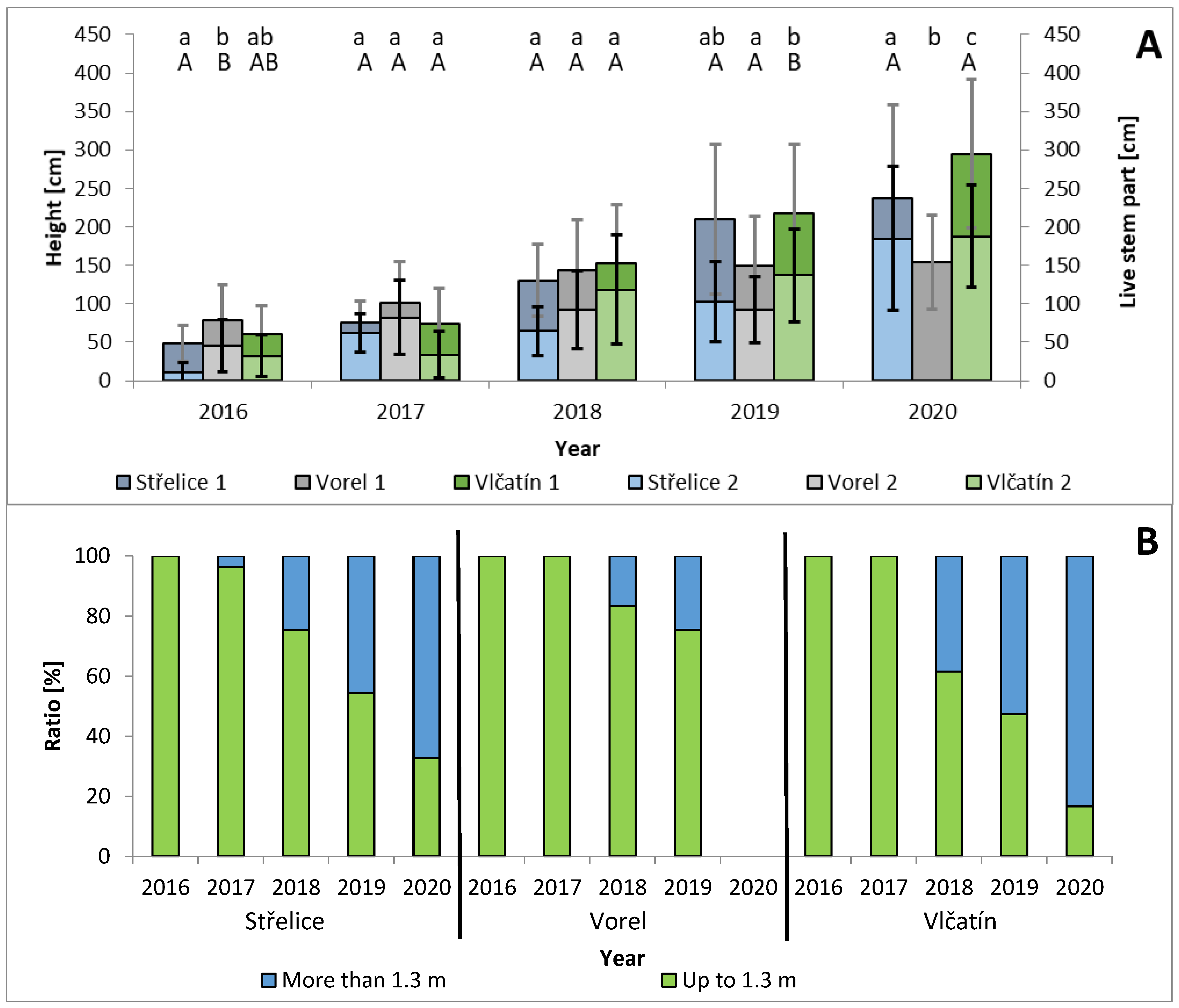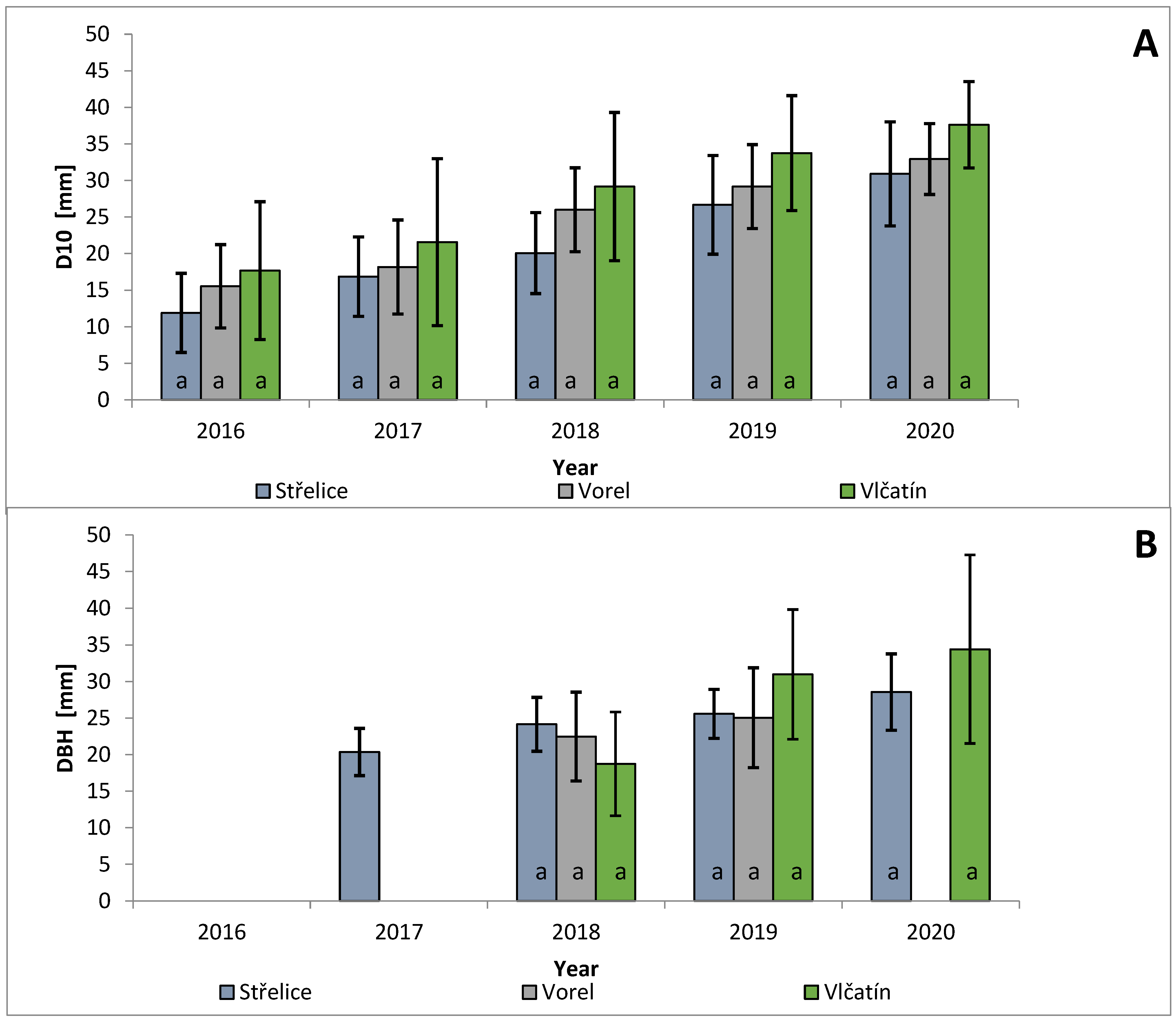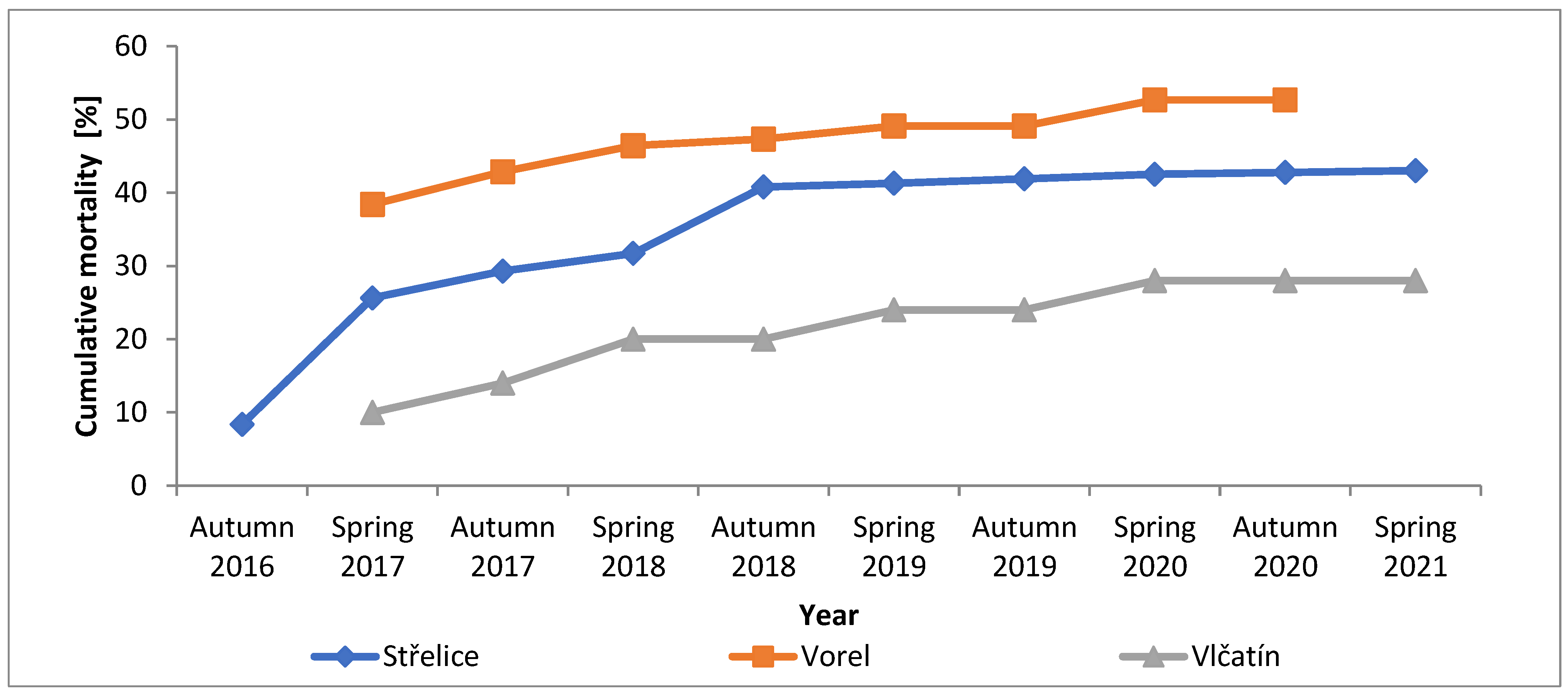Testing the Production Potential of Paulownia Clon In Vitro 112® in the Czech Republic
Abstract
1. Introduction
2. Materials and Methods
2.1. Description of Research Plots
2.1.1. Střelice
2.1.2. Vlčatín
2.1.3. Vorel
2.2. Description of Planting and Method of Cultivation
2.3. Method of Measurement
2.4. Statistical Analysis
3. Results
3.1. Height and Live Stem Part
3.2. D10 and DBH
3.3. Mortality
4. Discussion
5. Conclusions
Author Contributions
Funding
Data Availability Statement
Acknowledgments
Conflicts of Interest
References
- Icka, P.; Damo, R.; Icka, E. Paulownia Tomentosa, a Fast Growing Timber. 2016. Available online: https://www.researchgate.net/publication/309656225_Paulownia_Tomentosa_a_Fast_Growing_Timber (accessed on 23 March 2023).
- Zhu, Z.-H.; Chao, C.-J.; Lu, X.-Y.; Xiong, Y.G. Paulownia in China: Cultivation and Utilization. 1986. Available online: https://paulowniamp.files.wordpress.com/2010/05/paulownia-in-china.pdf (accessed on 23 March 2023).
- Hall, B. Strickberger’s Evolution: The Integration of Genes, Organisms and Populations; Jones and Bartlett Sudbury: Sudbury, MA, USA, 2008; p. 760. [Google Scholar]
- Oxytree. Investice Do Budoucnosti! [Investing in the Future!]. 2016. Available online: http://oxytree.cz/co-je-oxytree/ (accessed on 23 March 2023). (In Czech).
- UCLM. Badanie Warto’sci Gospodarczej Odmian (VCU). Testowanie Clon In Vitro 112. Hibrid Paulownia Elongata × Paulownia Fortunei. Sprawozdanie Techniczne (Czerwiec 2013). [The Economic Value of Varieties (VCU) Survey. Testing Clon In Vitro 112. Hybrid Paulownia Elongace × Paulownia Fortunei. Technical Report (June 2013)]. 2013. Available online: http://x-plus.pl/wpcontent/uploads/oxytree-vcu_report-PL.pdf (accessed on 23 March 2023). (In Polish).
- Cerro-Barja Del, A. Informe del Proyecto de Investigación: “Forestación de Zonas Semiráridas de Castilla-La Mancha noc Paulownia spp.”. [Information from the Investigation Project: “Forest of Semi-Arid Areas of Castilla-La Mancha noc Paulownia spp.”]. 2009. Available online: https://invitro.es/wp-content/themes/invitro/downloads/INFORME-FINAL-PAULOW.pdf (accessed on 23 March 2023). (In Spanish).
- Essl, F. From ornamental to detrimental? The incipient invasion of Central Europe by Paulownia Tomentosa. Preslia 2007, 79, 377–389. [Google Scholar]
- Snow, W.A. Ornamental, crop, or invasive? The history of the Empress tree (Paulownia) in the USA. For. Trees Livelihoods 2015, 24, 85–96. [Google Scholar] [CrossRef]
- Pergl, J.; Sádlo, J.; Petrusek, A.; Laštůvka, Z.; Musil, J.; Perglová, I.; Šanda, R.; Šefrová, H.; Šíma, J.; Vohralík, V.; et al. Black, Grey and Watch Lists of alien species in the Czech Republic based on environmental impacts and management strategy. NeoBiota 2016, 28, 1–37. [Google Scholar] [CrossRef]
- Act No. 334/1992 Sb. Zákon České Národní Rady o Ochraně Zemědělského Půdního Fondu [Act of the Czech National Council on the Protection of Agricultural Land Funds]. Available online: https://eagri.cz/public/web/mze/legislativa/pravni-predpisy-mze/tematicky-prehled/Legislativa-MZe_uplna-zneni_zakon-1992-334-ochranaZPF.html (accessed on 3 July 2023). (In Czech).
- Hybrid Paulownia Tree. 2023. Available online: https://www.ipaulownia.com/en/shop/hybrid-paulownia-tree-cotevisa-2/ (accessed on 3 July 2023).
- Paulownia. 2023. Available online: https://invitro.es/paulownia-en/ (accessed on 3 July 2023).
- Are Paulownia Trees Invasive? 2021. Available online: https://www.chinesepaulownia.com/faq/are-paulownia-trees-invasive/ (accessed on 3 July 2023).
- Paulownia. 2022. Available online: https://www.treeme.com/en/paulownia-en (accessed on 3 July 2023).
- Mal’ová, M.; Jankovič, J.; Sujová, K.; Longauerová, V.; Mútňáková, M. Paulownia—Potenciál a riziká pestovanie na Slovensku [Paulownia—Potential and risk of its cultivation in Slovakia]. In Proceedings of the Conference: Aktuálne Problémy v Ochrane lesa 2016, Nový Smokovec, Slovakia, 21–22 January 2016; pp. 87–95. [Google Scholar]
- Paulownia Slovakia. Dôležité Informácie o Typoch Paulownie. [Important Information about Paulownia Types]. 2022. Available online: https://www.paulownia-slovakia.eu/ekologia/paulownia-v-eu/ (accessed on 20 January 2022).
- Chinesepaulownia. Species of Paulownia. 2021. Available online: https://www.chinesepaulownia.com/about-chinese-paulownia (accessed on 23 March 2023).
- Bikfalvi, M. Paulownia—The Intelligent Tree. 2014. Available online: http://www.paulowniagreene.ro/wp-content/uploads/2012/11/Paulownia-Clon-in-Vitro-and-Paulownia-Cotevisa-2-Presentation-EN.pdf (accessed on 23 March 2023).
- Moreno, J.L.; Bastida, F.; Ondono, S.; García, C.; Andrés-Abellán, M.; Lopez-Serrano, F. Agro-forestry management of Paulownia plantations and their impact on soil biological quality: The effects of fertilization and irrigation treatments. Appl. Soil Ecol. 2017, 40, 46–56. [Google Scholar] [CrossRef]
- Paulownia Clon In Vitro 112®. 2021. Available online: https://www.paulownia112.com/#paulownia (accessed on 23 March 2023).
- Trademarkia. Paulovnia Clon In Vitro 112. 2022. Available online: https://trademark.trademarkia.com/wipo/trademark-1181727.htm (accessed on 23 March 2023).
- García-Morote, F.A.; López-Serrano, F.R.; Martínez-García, E.; Andrés-Abellán, M.; Dadi, T.; Candel, D.; Rubio, E.; Lucas-Borja, M.E. Stem Biomass Production of Paulownia elongata × P. fortunei under Low Irrigation in a Semi-Arid Environment. Forests 2014, 5, 2505–2520. [Google Scholar] [CrossRef]
- Cuomo, F. Progetto Clone In Vitro 112®. La Nuova Grande Opportunita per L’agricoltura. [Progetto Clone In Vitro 112®. The New Great Opportunity for Agriculture]. 2014. Available online: https://paperzz.com/doc/5214373/progetto-paulownia-clone-in-vitro-112 (accessed on 23 March 2023).
- Forbes. To Drzewo Uratuje Ludzskość? [Will This Tree Save Humanity?]. 2016. Available online: https://www.forbes.pl/innogy/nauka-i-spoleczenstwo/oxytree-drzewo-ktore-szybko-rosnie-i-produkuje-duzo-tlenu/9qehy83 (accessed on 23 March 2023).
- International Hardiness Zone Maps. 2023. Available online: https://www.plantmaps.com/index.php (accessed on 2 June 2023).
- Köppen, W. Das Geographische System der Klimate [Geographic System of Climates]; Handbuch der Klimatologie; Verlag von Gebrüder Borntraeger: Berlin, Germany, 1936. [Google Scholar]
- WRB IUSS Working Group WRB. World Reference Base for Soil Resources 2014, Update 2015; International Soil Classification System for Naming Soils and Creating Legends for Soil Maps; World Soil Resources Reports No. 106; FAO: Rome, Italy, 2015. [Google Scholar]
- Historical Data—Weather—Historical Data. 2020. Available online: http://portal.chmi.cz/historicka-data/pocasi/zakladniinformace?l=en (accessed on 23 March 2023).
- Vyskot, M. Pěstění Lesů [Silviculture]; SZN: Praha, Czech Republic, 1978; p. 432. (In Czech) [Google Scholar]
- Barton, I.; Micholas, I.; Ecroyd, C. Paulownia: Forest Research Bulletin; Forest Research Bulletin: Rotorua, New Zealand, 2007; p. 76. [Google Scholar]
- El-Showk, S.; El-Showk, N. The Paulownia Tree an Alternative for Sustainable Forestry. 2003. Available online: http://cropdevelopment.org/docs/PaulowniaBooklet.pdf (accessed on 23 March 2023).
- Jablonski, D. Surowiec Drzewny. Oxytree: Drewno do Przerobu w Tartaku w 6 lat od Posadzenia Drzewa [Wood Raw Material. Oxytree: Wood for Processing at a Sawmill 6 Years after Planting the Tree]. 2016. Available online: http://www.drewno.pl/artykuly/10535,oxytree-drewno-do-przerobu-w-tartaku-w-6-lat-od-posadzenia-drzewa.html (accessed on 23 March 2023). (In Polish).
- TGG. Paulownia: Technical Bulletin. 2011. Available online: https://www.doc-developpement-durable.org/file/Culture/Arbres-Bois-de-Rapport-Reforestation/FICHES_ARBRES/Paulownia/Paulownia%20plantations.pdf (accessed on 23 March 2023).
- BIO TREE. Paulownia. 2022. Available online: https://paulowniatrees.eu/products/paulownia-planting-material/ (accessed on 23 March 2023).
- Trewartha, T. An Introduction to Weather and Climate; McGraw-Hill Book Company: New York, NY, USA, 1943; p. 545. [Google Scholar]



| Temperature | |||||||||||||
|---|---|---|---|---|---|---|---|---|---|---|---|---|---|
| I. | II. | III. | IV. | V. | VI. | VII. | VIII. | IX. | X. | XI. | XII. | ||
| Vorel | 2016 | −2.5 | 2.5 | 2.7 | 7.0 | 12.9 | 16.9 | 18.2 | 16.4 | 15.0 | 6.9 | 1.8 | −1.6 |
| 2017 | −6.5 | 0.1 | 5.4 | 6.2 | 13.5 | 17.7 | 17.9 | 18.7 | 11.3 | 8.7 | 3.0 | −0.1 | |
| 2018 | 0.5 | −4.5 | 0.0 | 12.5 | 16.3 | 17.2 | 19.5 | 20.7 | 14.0 | 9.6 | 4.0 | −0.3 | |
| 2019 | −3.1 | 0.5 | 4.7 | 9.1 | 10.3 | 20.2 | 18.2 | 19.0 | 12.6 | 8.6 | 5.2 | 0.6 | |
| 2020 | −1.4 | 2.7 | 3.4 | 8.4 | 10.5 | 16.1 | 17.0 | 18.4 | 13.2 | 8.4 | 3.1 | 0.8 | |
| Střelice | 2016 | −1.3 | 4.4 | 4.9 | 9.0 | 14.9 | 18.8 | 20.1 | 18.2 | 17.0 | 8.7 | 3.6 | −0.5 |
| 2017 | −5.5 | 1.3 | 7.4 | 8.4 | 15.2 | 20.1 | 20.4 | 20.8 | 13.2 | 10.1 | 4.6 | 1.6 | |
| 2018 | 1.9 | −2.0 | 2.1 | 14.1 | 18.0 | 19.6 | 21.5 | 22.8 | 16.0 | 11.1 | 5.6 | 1.5 | |
| 2019 | −0.9 | 2.4 | 6.7 | 11.1 | 12.2 | 22.0 | 20.3 | 20.8 | 14.6 | 9.9 | 6.8 | 2.0 | |
| 2020 | −0.2 | 4.6 | 5.3 | 9.9 | 12.6 | 18.0 | 19.2 | 20.6 | 15.0 | 10.1 | 4.5 | 2.4 | |
| Vlčatín | 2016 | −2.0 | 3.3 | 3.5 | 7.8 | 13.9 | 18.2 | 19.6 | 17.4 | 15.8 | 7.4 | 2.4 | −1.0 |
| 2017 | −6.1 | 0.6 | 6.0 | 7.0 | 14.6 | 19.3 | 19.5 | 19.6 | 11.9 | 9.2 | 3.6 | 0.4 | |
| 2018 | 1.3 | −3.5 | 0.9 | 13.0 | 17.1 | 18.2 | 20.2 | 21.3 | 14.2 | 9.8 | 4.3 | 0.3 | |
| 2019 | −2.1 | 1.1 | 5.2 | 9.4 | 11.0 | 21.0 | 19.2 | 19.6 | 13.0 | 8.6 | 5.8 | 0.9 | |
| 2020 | −0.9 | 3.3 | 4.1 | 8.8 | 11.2 | 16.7 | 18.0 | 18.9 | 13.4 | 8.7 | 3.4 | 1.4 | |
| Precipitation | |||||||||||||
| I. | II. | III. | IV. | V. | VI. | VII. | VIII. | IX. | X. | XI. | XII. | ||
| Vorel | 2016 | 30.6 | 72.8 | 44.4 | 51.8 | 83.5 | 75.7 | 122.3 | 30.5 | 15.5 | 42.4 | 35.2 | 29.0 |
| 2017 | 36.6 | 23.3 | 50.4 | 62.3 | 57.4 | 79.2 | 114.6 | 40.6 | 73.6 | 84.4 | 38.4 | 24.7 | |
| 2018 | 43.7 | 16.9 | 21.0 | 22.3 | 49.0 | 61.0 | 36.6 | 15.4 | 91.9 | 27.4 | 20.0 | 53.0 | |
| 2019 | 69.7 | 25.8 | 52.4 | 12.3 | 117.1 | 69.0 | 32.3 | 69.4 | 64.4 | 37.8 | 49.5 | 46.0 | |
| 2020 | 23.3 | 98.2 | 42.7 | 20.6 | 70.7 | 146.4 | 100.9 | 160.2 | 82.4 | 96.3 | 27.3 | 31.8 | |
| Střelice | 2016 | 17.6 | 64.5 | 20.3 | 41.1 | 17.0 | 54.7 | 113.6 | 46.9 | 10.7 | 20.9 | 20.0 | 9.3 |
| 2017 | 19.1 | 7.8 | 21.0 | 30.5 | 53.2 | 41.9 | 82.7 | 42.2 | 63.4 | 36.1 | 19.0 | 10.6 | |
| 2018 | 33.4 | 10.6 | 12.4 | 10.7 | 36.1 | 35.7 | 39.7 | 15.0 | 86.4 | 14.3 | 22.7 | 25.8 | |
| 2019 | 23.0 | 17.2 | 26.5 | 16.9 | 78.1 | 65.4 | 62.6 | 55.9 | 72.6 | 31.5 | 40.1 | 42.9 | |
| 2020 | 8.5 | 27.1 | 25.7 | 20.3 | 67.3 | 87.2 | 58.9 | 105.9 | 81.6 | 130.1 | 23.4 | 36.8 | |
| Vlčatín | 2016 | 25.0 | 42.0 | 29.7 | 39.8 | 42.1 | 39.7 | 97.6 | 21.0 | 15.4 | 33.7 | 29.9 | 29.9 |
| 2017 | 26.2 | 14.3 | 42.3 | 58.8 | 26.1 | 36.7 | 82.9 | 38.7 | 79.7 | 64.1 | 42.9 | 23.6 | |
| 2018 | 43.0 | 16.8 | 21.9 | 24.1 | 73.5 | 69.5 | 30.5 | 18.5 | 70.6 | 34.1 | 25.2 | 66.6 | |
| 2019 | 76.6 | 24.5 | 52.9 | 16.2 | 97.9 | 85.2 | 37.2 | 60.7 | 86.6 | 33.8 | 47.4 | 43.2 | |
| 2020 | 14.6 | 65.1 | 27.2 | 37.4 | 71.8 | 197.8 | 72.6 | 150.7 | 66.9 | 77.7 | 31.2 | 24.5 | |
| 2016 | 2017 | 2018 | 2019 | 2020 | |
|---|---|---|---|---|---|
| Vorel | −12.2 | −12.4 | −13.1 | −11.1 | −4.4 |
| Vlčatín | −10.8 | −12.4 | −11.8 | −8.6 | −3.3 |
| Střelice | −9.0 | −11.4 | −10.2 | −6.9 | −3.8 |
| Vorel | Vlčatín | Střelice | |
|---|---|---|---|
| Mean annual precipitation | 650 | 600 | 480 |
| Mean monthly precipitation (from the annual) | 55 | 50 | 40 |
| Precipitation during the growing period | 390 | 370 | 320 |
| Mean monthly precipitation (from the growing period) | 65 | 60 | 55 |
Disclaimer/Publisher’s Note: The statements, opinions and data contained in all publications are solely those of the individual author(s) and contributor(s) and not of MDPI and/or the editor(s). MDPI and/or the editor(s) disclaim responsibility for any injury to people or property resulting from any ideas, methods, instructions or products referred to in the content. |
© 2023 by the authors. Licensee MDPI, Basel, Switzerland. This article is an open access article distributed under the terms and conditions of the Creative Commons Attribution (CC BY) license (https://creativecommons.org/licenses/by/4.0/).
Share and Cite
Kadlec, J.; Novosadová, K.; Kománek, M.; Pokorný, R. Testing the Production Potential of Paulownia Clon In Vitro 112® in the Czech Republic. Forests 2023, 14, 1526. https://doi.org/10.3390/f14081526
Kadlec J, Novosadová K, Kománek M, Pokorný R. Testing the Production Potential of Paulownia Clon In Vitro 112® in the Czech Republic. Forests. 2023; 14(8):1526. https://doi.org/10.3390/f14081526
Chicago/Turabian StyleKadlec, Jiří, Kateřina Novosadová, Martin Kománek, and Radek Pokorný. 2023. "Testing the Production Potential of Paulownia Clon In Vitro 112® in the Czech Republic" Forests 14, no. 8: 1526. https://doi.org/10.3390/f14081526
APA StyleKadlec, J., Novosadová, K., Kománek, M., & Pokorný, R. (2023). Testing the Production Potential of Paulownia Clon In Vitro 112® in the Czech Republic. Forests, 14(8), 1526. https://doi.org/10.3390/f14081526







